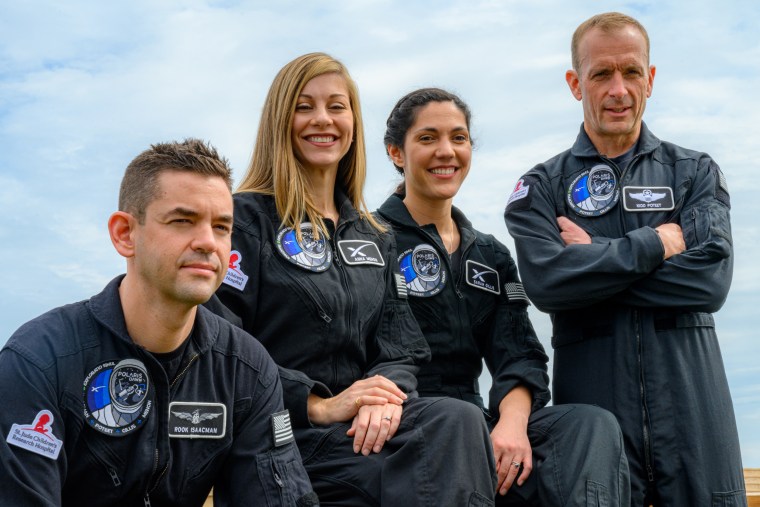Days after returning to Earth, the four civilian crew members of the Polaris Dawn mission opened up about their experience seeing the planet from orbit, floating in weightlessness and conducting the world’s first all-civilian spacewalk.
In an exclusive interview with NBC’s Lester Holt, which will air on NBC Nightly News on Tuesday, the crew — billionaire entrepreneur Jared Isaacman, retired Air Force Lt. Col. Scott “Kidd” Poteet and SpaceX engineers Sarah Gillis and Anna Menon — described the emotional side of their five-day journey.
“The perfection of what you’re looking at is just awe-inspiring,” Poteet said, recalling the views of sunrises and sunsets out the window of their SpaceX Crew Dragon capsule. “It’s so mesmerizing because it’s such a beautiful planet.”

The crew launched into orbit on Tuesday, Sept. 10 and splashed down early Sunday in the Gulf of Mexico, off the Florida coast.
Isaacman described the thrill and anxieties of plummeting through Earth’s atmosphere with only the spacecraft’s heat shield protecting it and those inside from extreme temperatures.
“When you’re launching, that’s nothing but cheers, excitement, enthusiasm, because you have a lot of options available to get out of a bad situation, should it come to be,” Isaacman said. “But on the way down, it’s all the heat shield … There’s no plan B. You know that is going to be your higher blood pressure moment.”
Adding to the intensity were the high G-forces the crew experienced on re-entry.
“It’s a heck of a ride downhill for sure,” Isaacman said.
During their journey, the crew reached the highest orbital altitude that humans have attained since the final Apollo moon mission in 1972 and completed a risky, first-of-its-kind spacewalk.
Early Thursday morning, Isaacman and Gillis exited the capsule on a tether and each spent around 10 minutes in the vacuum of space to conduct mobility tests in newly designed spacesuits.
It was a landmark moment in commercial spaceflight: Previously, only astronauts from government space agencies had conducted spacewalks.
Isaacman described the outing as a “sensory overload.”
“It’s not just the visual stimulus of seeing Earth right in front of you,” he said. “There are pressure changes, there are big temperature transients. It gets gets colder. There’s the physical exertion of moving the hatch, so it was rather intense.”
Isaacman and Gillis were the only ones to exit the spacecraft, but all four crew members technically took part because the Dragon capsule does not have an airlock. That meant that when the hatch was opened, the entire vehicle was depressurized and exposed to vacuum conditions. So Poteet and Menon wore spacesuits for the duration as well.
“We had the best seat in the house,” Poteet said.
The crew spent two-and-a-half years training for the Polaris Dawn mission, which included choreographing and rehearsing each step of the spacewalk. Gillis said the flight demonstrated what private companies can accomplish in space.
“I think the world saw something a little different,” she said. “Maybe it sparked imagination, something from a slightly different perspective.”
The flight was designed to be a stepping stone toward future long-duration trips to the moon and eventually Mars, according to Isaacman, who funded the mission for an undisclosed sum in partnership with SpaceX. (The crew members also raised money for St. Jude Children’s Research Hospital during their time in orbit.)
Because the crew members reached an orbital altitude of 870 miles above Earth’s surface, they passed through the inner regions of the Van Allen radiation belt, a zone of high-energy radiation particles trapped by Earth’s magnetosphere.
Menon joked that they got “more than a few” X-rays out of the experience, but added that studying the effects of that radiation can help scientists understand how to protect people and spacecraft from the harsh conditions of outer space.
“We were taking all sorts of data to be able to learn more through science and research about the human response to that environment,” she said. “We will take all of this back, learn from it, and then be able to go further based on this.”
Polaris Dawn is slated to be the first of three flights in the Polaris program. Isaacman has not disclosed the total cost of the program nor the timeline or plans for the two remaining missions.
He said the larger goal for both SpaceX and the Polaris program is to eventually make humans a multiplanetary species. But he noted that spaceflight also has shorter-term benefits.
“That’s how people learn, that’s how people are inspired, and that’s how you go out and do bigger and bolder things in the future,” Isaacman said.





